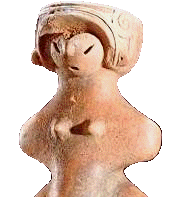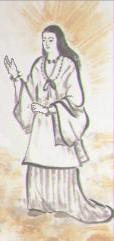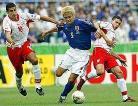| |||||||||

 |
Is the Japanese imperial genealogy unbroken?
(Mysteries of Emperor Keitai) by Akira Kato
July 12, 2003
Why was it necessary that the royal lineage was unbroken?Is the genealogy of the Japanese imperial family truly unbroken? Before answering this question, we should think about the reason why it was necessary that the family tree was unbroken in ancient times. This would be the shortcut to get the answer. Normally, in our daily life, we don’t really care about the genealogy of the Japanese Imperial Family—let alone the English or Swedish royal Family. Why not? We don’t really care about it because the Imperial genealogy does not have anything to do with our daily life. In ancient times, therefore, the Imperial family tree had a great meaning to daily life—at least to certain people. Otherwise, these pepole’s lives were threatened. If you were one of them, you would have to insist that the family tree was unbroken. If you could’t proove it, your life might be jeopadized. Naturally, you wonder who those people were. You might have already got the answer because a big hint was given with the title of this page. Of course, those people were Emperor Keitai (King Ohoto of Koshi Kingdom) and his men. Scholars say that the present Imperial Family has an unbroken relationship with King Ohoto—the 25th empror. Ironically speaking, then, why Emperor Keitai? Why not some other emperor before him? Before Emperor Keitai ascended the throne, nobody seemed to have cared about the genealogy of the Imperial family. Looking back into the ancient Japanese history, you will find another emperor who had rewritten the family tree or the Japanese history in general. It is Emperor Temmu, who ascended the throne after the Jinshin rebellion. With the probability of 99 percent, the new dynasty came into being at this time. If you want to know more about this incident, please visit this page: Emperors Tenchi and Temmu were stepbrothers.
In fact, this particular educational system had produced millions of Imperial soldiers who died for the emperor, shouting “His Majesty the Emperor hurray!” while charging toward the enemy front. For this reason, the government had created the “Imperial National View of History”.
Why did King Ohoto have to come up with the “Unbroken Imperial Geneology of Ten Thousand Generations”?Since Emperor Buretsu didn’t leave any legitimate son, a strife took place over the succession. Some scholars belive that Kanamura Otomo, one of the powerful court officials, invited King Ohoto of Koshi Kingdom to take over the throne, because King Ohoto was a 6th-generation descendant from Emperor Oujin. However, it took nearly 20 years for him to settle in Yamato. It was far too long for King Ohoto to be welcomed by the Yamato Dynasty. During that period, he had wandered around in Kawachi and Yamashiro. In any case, the succession did’t go through smoothly. If you take an assumption that King Ohoto had nothing to do with the Imperial family, the whole thing explains itself with ease. When the Yamato Dynasty faced the succession proglem, King Ohoto saw it as a heaven-sent opportunity and invaded the dynasty to take over the throne. Bun the king met a strong resistance. So, it took him 20 years to ascend the throne. He might have either conquered the Yamato dynasty or reached a truce before taking over the throne. According to Nihon-shoki or the Chronicle of Japan, the father of King Ohoto was a thane who had a sway over Omi and his mother was Furu-hime, the daughter of a thane in Echizen—present-day Fukui Prefecture. Although the vestige of King Ohoto in Echizen is not clear, he has left many legends, among which are the flood-control of the Echizen plain and the mining legend of Shakuya-stone. In 1884, the Shakuya-stone miners erected the statue (shown at top) in the San-dan square at Ashiba Mountain, to honor the virtue of Emperor Keitai. The statue was made of Shakuya-stone and faces the estuary of the Kuzuryu River, alog which his legendary river works were performed to overcome floods. But Emperor Keitai remains mysterious. Nobody knows when he was born and exactly when he died. Scholars have various theories about his upbringing before he ascended the throne. They all agree, however, that Emperor Keitai was the earliest emperor to whom the present imperial family can go back genealogically. I can sense something fishy about it because, though other things remained unclear, the above fact seemed undisputable. Why was Emperor Keitai the earliest emperor despite his other related matters being so uncertain? This is an unavoidable question, isn’it? According to the Chronicle of Japan, Emperor Keitai was born in Omi and brought up on the Fukui plain. But scholars used to suspect these facts. The recent studies and findings of archaeology and philology, however, verify those facts, and scholars believe that he was brought up with the powerful clans in present-day Fukui and, once grown up, went to Yamato with support of powerful clans in Hokuriku, Omi and Owari. Yet, they don’t know what kind of person he was, why a provincial man like King Ohoto could suddenly become an emperor, what sort of background he had, and what relationship existed in terms of military power between King Ohoto and the Yamato Dynasty. But it seemed quite important that the mother of Emperor Keitai was a daughter of a powerful Echizen thane and he was brought up with support of the powerful clan background. As described in this page (The head and tail of Japan were switched in the modern times) and shown in the map below, the refugees from the continent and the ancient Koreans came to Japan during the period around A.D. 450 when King Ohoto was born.
The above map shows the struggling countries during the Sui period (589 - 618). Around A.D. 450, when King Ohoto was born, the so-called “period of the Southern and Northern Dynasties (420-588)” had started in China and disturbances of war remained more prevalent than in the Sui period. Therefore, the more refugees from the continent and the Korean peninsulaces must have escaped to Japan. Among these people were the officers and men who were defeated in the wars. The thane in Echizen received those escaped military men who had advanced weapons and new strategic knowledge and he gradually became poweful. Furu-hime, the mother of King Ohoto beloned to this clan in Echizen. Furu-hime herself might have escaped to Echizen from the Korean peninsula to avoid the disturbances of war. She might have been the daughter of a defeated military lord in Silla. Since the birthdate of King Ohoto is uncertain, he might also have come to Japan with his mother. So, King Ohoto might have been brought up as a stepchild. If this assumption turns out true, then King Ohoto diidn’t have even a drop of Japanese blood. In any case, the Echizen clan must have received a great number of refugees from the peninsula. The recent findings of the archeological excavation support that more powerful kingdoms were located on the Japan-Sea side than on the Pacific and that advanced technology, including the ironware and the weapon, was brought by the people from the peninsula.
How does it have anything to do with the “Unbroken Imperial Geneology of Ten Thousand Generations”?According to the Chronicle of Japan, King Ohoto had nine wives and the Records of Ancient Matters tells us that he had seven. This doesn’t mean, of course, that the king was a sex-crazed man or a man of extremely high libido (sex drive). The head of a powerful clan in ancient times had a number of spouses. It was not unusual to have made the said number of women serve nearby at the time. This was the result of a marriage of convenience to strengthen his own power base with the wife’s family. By the way, the Chronicle of Japan and the Records of Ancient Matters describe those wives in a different order. Scholars believe that the Chronicle of Japan talk about these women in the order of wife’s grade while the Records of Ancient Matters in the order of marriage date. The families of his wives were located in, beside Echizen, Omi, Mino, and Owari—places of strategic importance in terms of both land and water traffic. In any case, if you take a close look at his marriages, you will notice that King Ohoto took advantage of these marriages not only to expand his power, but also to hide his origin. In other words, to govern the country as an emperor, it was desirable for his parents to be native Japanese. His mother, Furu-hime, might have been a naturalized Korean. I even suspect that King Ohoto was born in Silla and her mother came to Japan while holding the infant Ohoto in her arms. The best way to make up for his disadvantage as an immigrant was to obtain the powerful Japanese partners by way of marriage. With this expedience in mind, King Ohoto and his men chose the Owari clan,and he married Menoko-hime, who would later give birth to the future emperors—Ankan and Senka. In Nagoya City, there is the ancient key-hole-shaped tomb called “Tateo-yama Kofun”, which is the largest key-hole-shaped tomb in East Japan and was built by this Owari Clan. Apparently, once he had left Echizen, King Ohoto chose Owari as the headquarters to govern the eastern Japan. The Chronicle of Japan describes Miono-tsunoori-kimi as the third wife and Miono-kimi as the seventh. A group of scholars consider that both women came from present-day Fukui Prefecture while another group of scholars believe that these two women came from Shiga. Taking into consideration the intension of King Ohoto, I take the Shiga theory because, instead of increasing the power base in Fukui, King Ohto probably wanted to expand into other regions. Shiga Prefecture has Mio Shrine that enshrined the ancestor of Miono-kimi. Shiga also has an area called Miono-sato. As you notice, Miono-sato and Miono-kimi share the same word that has the same pronunciation. This is only one example, and Shiga has other places whose name contains “Mio”. Miono-kimi came from the area that stretches from Adogawa Town to Takashima Town. The Shiga faction believe that Miono-kimi had something to do with the ancient tomb called “Mount Kamo-inari Kofun” from which a gold-copper crown and some accesories were excavated. On the other hand, the Fukui faction state that Kanazu Town has a place called “Misuno-o”, which was originally called “Mio”. In any case, though he had already married a number of women, King Ohoto didn’t think that these marriage had not meet his needs. To finish it off, he married Tashirakano-himemiko, who would later give birth to Emperor Kimmei. She was the daughter of an emperor of the Yamato Dynasty, and served as a passport for King Ohoto when he entered Yamato. By now, you have probably understood why King Ohoto considered it extremely important to belong to the “Unbroken Imperial Geneology of Ten Thousand Generations”.
World Cup Trivia
The biggest upset in a final occurred at the 1998 World Cup, when Host France thrashed favorites
Brazil 3 - 0.
The 1950 World Cup was the only competition without a real final. Host Brazil needed only a draw against Uruguay to win. A world record 200,000 fans watched as Uruguay came from behind to win 2 -1.
For safe, secure betting use North America’s first online Sportsbook Sports Interaction. Licensed and Regulated. | ||||||||
| |||||||||


















 As with a recent example, the Japanese government from Meiji to the
end of the second World War, though it did not write a brand new genealogy,
took a nationalistic educational policy, in which the genealogy of the
Imperial Family had been continuing from Emperor Jimmu to the Emperor Showa
without even a slight gap based on the “Imperial National View of
History”.
The teachers taught pupils the “Unbroken Imperial Genealogy of Ten
Thousand Generations” so that Emperor Showa was traced back to Sun goddess Amaterasu
and that the people could consider the emperor to be a living god.
As with a recent example, the Japanese government from Meiji to the
end of the second World War, though it did not write a brand new genealogy,
took a nationalistic educational policy, in which the genealogy of the
Imperial Family had been continuing from Emperor Jimmu to the Emperor Showa
without even a slight gap based on the “Imperial National View of
History”.
The teachers taught pupils the “Unbroken Imperial Genealogy of Ten
Thousand Generations” so that Emperor Showa was traced back to Sun goddess Amaterasu
and that the people could consider the emperor to be a living god.


 Possibly the most infamous goal in the World Cup was scored in 1986, when archrivals Argentina and England met. Argentina’s Diego Maradona leapt high for a ball and used his hand to tap it past the goalkeeper and into the net. The goal became known as the “The Hand of God”.
Possibly the most infamous goal in the World Cup was scored in 1986, when archrivals Argentina and England met. Argentina’s Diego Maradona leapt high for a ball and used his hand to tap it past the goalkeeper and into the net. The goal became known as the “The Hand of God”.  For a few, winning in the World Cup is not everything. In 1990 United Arab Emirates players were promised a Rolls-Royce for every goal the team scored. UAE lost all three games, but scored twice.
For a few, winning in the World Cup is not everything. In 1990 United Arab Emirates players were promised a Rolls-Royce for every goal the team scored. UAE lost all three games, but scored twice.
